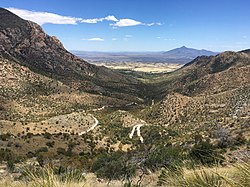Career in Yavapai County
By 1913, she was secretary/manager of the Yavapai County Chamber of Commerce and the county's Immigration Commissioner. She held the immigration commissioner position until 1945. [2] Sparkes also served on the Arizona State Board of Welfare and the Northern Arizona State Fair Association. [3]
While working with the Yavapai County Chamber of Commerce, Sparkes was credited with greatly building the Prescott Frontier Days rodeo. [2] She became known as "the girl who bosses 200 bronco busters." [4] She was also influential in developing rodeo rules, many of which are still used. [4] Sparkes is credited with developing Prescott's slogan, the "Cowboy Capital of the World." [1]
In 1920, Sparkes led a group of Prescott citizens to raise funds for the Hassayampa Hotel Company, which opened in 1927. [4] [5]
In 1921, Sparkes co-founded the Smoki Tribe of Prescott ceremonial dances. [2] The Smoki was a men's organization that imitated Native American ceremonies. [2] [6] Sparkes was the marketer for the Smoki and their activities, describing the Smoki dances as "adapted to the mood of the white man and given in a manner which [left] no offense whatsoever from the standpoint of the Indian." [6] Sparkes was made an honorary member of the Smoki people. [7] Her success in marketing the activities brought it to the national interest. In 1924, the event was attended by Governor George W. P. Hunt, and Sparkes, on a trip to Washington, D.C., conferred honorary membership on Calvin Coolidge. The national interest in the Smoki Sparkes garnered criticism of their activities as well; also in 1924, the Los Angeles Times criticized the Smoki as a "highly offensive, objectionable and indefensible exhibition of bad taste." [6]
Relief work in the Great Depression
Due to the excellent state of Prescott's tourism, the Great Depression did not fully reach the town until the spring of 1930. [7] As the effects presented themselves, Sparkes endeavored to decrease the impact of the economic crisis on Yavapai County. [8] She was instrumental in creating projects funding unemployed people throughout the county. [3]
In 1930, Sparkes advocated for voters to endorse Proposition 108, authorizing road resurfacing, which she claimed would increase employment. She also encouraged all Prescott businessmen to employ at least one unemployed citizen for at least one day during the first week of November. In mid-November, she announced 250 jobs for unemployed Prescott civilians working on municipal projects. By 1932, Sparkes was the local chairman in charge of relief projects. In this position, she implemented federal and municipal projects. [8]
In November 1934, she was named chairman of the Yavapai County Civil Works Administration. In just twelve days to meet the December 1 deadline, she worked to organize and obtain funding for nine construction projects. When funds ran low, she worked to show Washington that the projects were so unique a special dispensation should be made to continue them. However, the whole project was terminated by congressional action in February 1934. In April 1934, the Federal Emergency Relief Administration was established in place of the Civil Works Administration. Although Sparkes had been unjustly criticized in a national scandal regarding the misuse of CWA funds and other irregularities, she agreed to continue her work coordinating local relief. [8]

In 1930, Sparkes was appointed to the Chamber of Commerce's new Archaeological Committee, created to study, preserve, and promote Yavapai County's archaeological resources. This project hoped to identify archaeological sites to excavate, bringing in heritage tourism. They hoped to provide short-term economic benefits to workers and long-term tourism revenue. In 1933, Sparkes secured FERA funds for a project excavating, studying, and investigating the Tuzigoot prehistoric pueblo on United Verde Copper Company land and the construction of a museum. [3] Sparkes also secured CWA funding for people who could not do heavier manual labor. A laboratory staff of women and older workers, mostly from the Cottonwood and Clarksdale Hispanic communities, cleaned, repaired, and documented over 150 pottery vessels. [3] [9]
In 1934, when the Arizona legislature decided not to fund an exhibit for the Century of Progress exhibition, Sparkes raised funds and built an exhibit herself. [2]
Other work in Yavapai County
Sparkes was very interested in roads and road movement. Many scenic roads through the Southwest were successful due to her work. [7] Sparkes was instrumental in developing Interstate 10. [3]
In the 1930s, Sparkes successfully campaigned for more land to be added to the Montezuma Castle National Monument. [10]
In 1935, Sparkes, along with Sharlot Hall and Yavapai leaders Sam and Viola Jimulla, convinced the federal government to designate 75 acres (30 ha) of land to be a reservation for the Yavapai people. It was the first reservation solely for the Yavapai in the state. [1]
